Strategic Marketing Report: Zara's Strategic Marketing Analysis
VerifiedAdded on 2023/01/16
|19
|5202
|58
Report
AI Summary
This report provides a comprehensive strategic marketing analysis of Zara, a prominent global fashion retailer. It begins with an introduction and background of the company, followed by an overview of its mission and vision. The report then delves into a detailed discussion, starting with an internal market situation analysis using a SWOT framework, highlighting Zara's strengths, weaknesses, opportunities, and threats. This is followed by an analysis of external factors impacting Zara, including political, economic, and socio-cultural influences. The report then transitions to a marketing situation overview, including segmentation, targeting, positioning, and the marketing mix (4Ps). A BCG matrix analysis is also conducted to assess Zara's business units. Finally, the report concludes with strategic recommendations and suggestions for monitoring and controlling the implementation of the proposed strategies. The analysis is supported by relevant academic research and provides valuable insights into Zara's market position and strategic marketing approach.
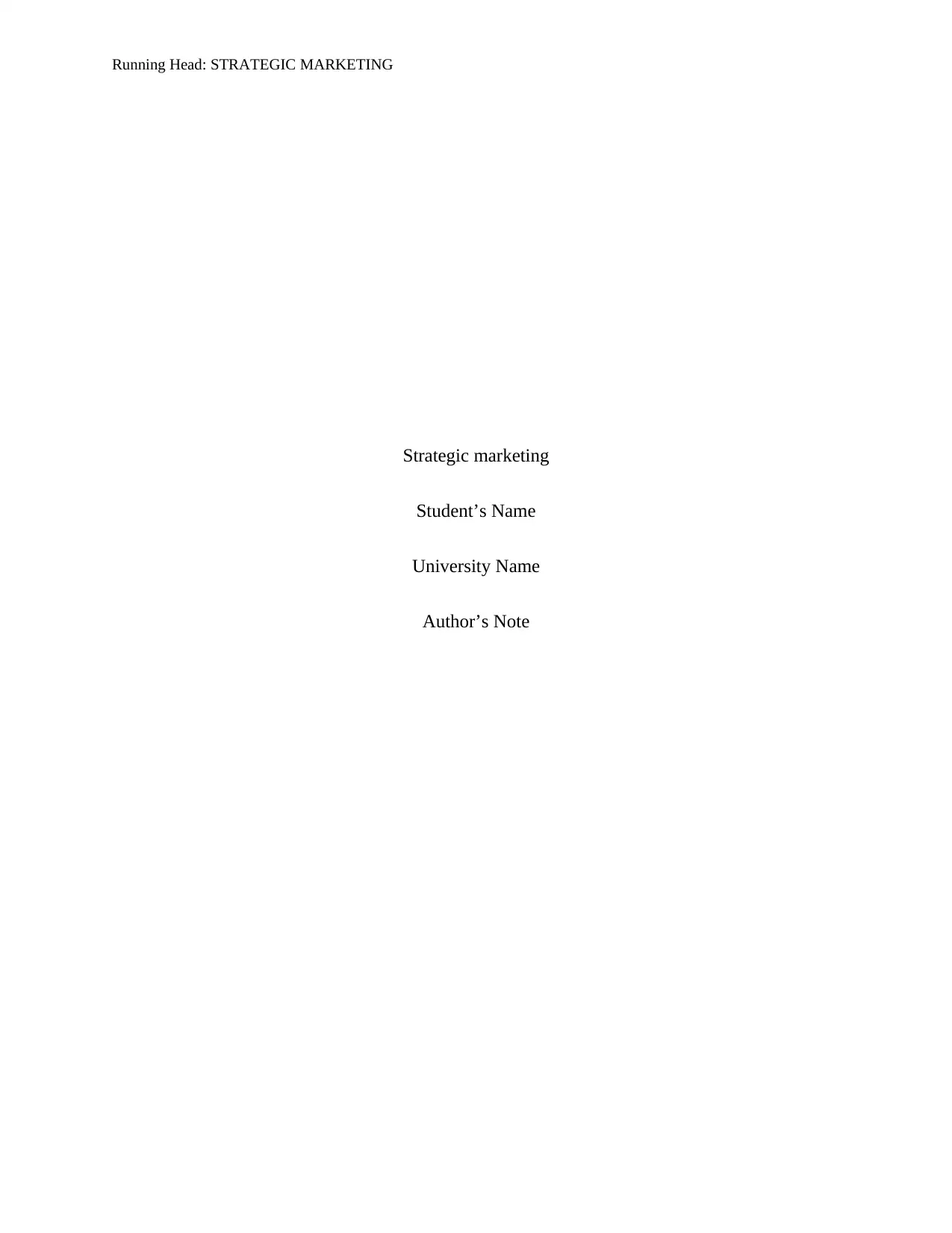
Running Head: STRATEGIC MARKETING
Strategic marketing
Student’s Name
University Name
Author’s Note
Strategic marketing
Student’s Name
University Name
Author’s Note
Paraphrase This Document
Need a fresh take? Get an instant paraphrase of this document with our AI Paraphraser
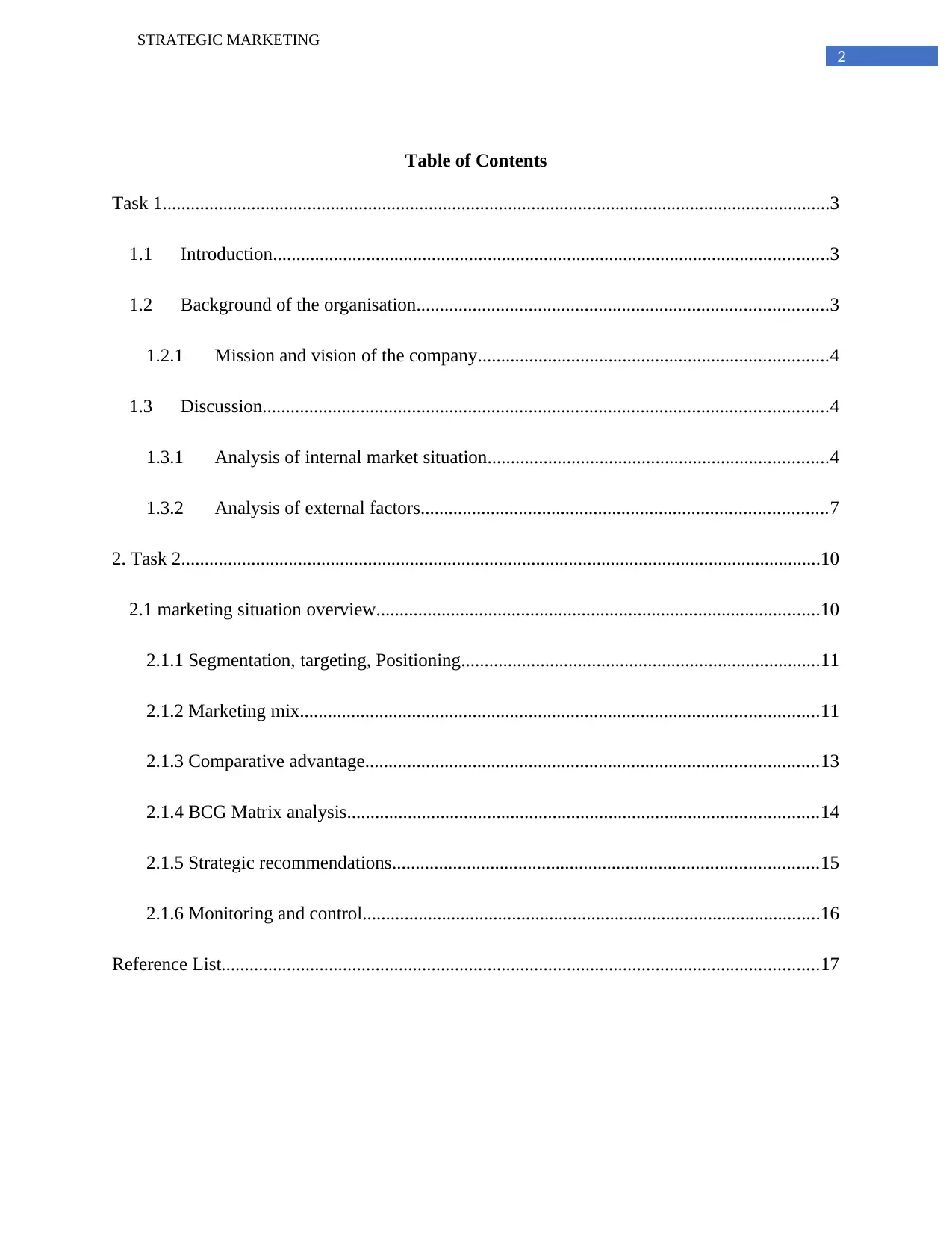
2
STRATEGIC MARKETING
Table of Contents
Task 1...............................................................................................................................................3
1.1 Introduction.......................................................................................................................3
1.2 Background of the organisation........................................................................................3
1.2.1 Mission and vision of the company...........................................................................4
1.3 Discussion.........................................................................................................................4
1.3.1 Analysis of internal market situation.........................................................................4
1.3.2 Analysis of external factors.......................................................................................7
2. Task 2.........................................................................................................................................10
2.1 marketing situation overview...............................................................................................10
2.1.1 Segmentation, targeting, Positioning.............................................................................11
2.1.2 Marketing mix...............................................................................................................11
2.1.3 Comparative advantage.................................................................................................13
2.1.4 BCG Matrix analysis.....................................................................................................14
2.1.5 Strategic recommendations...........................................................................................15
2.1.6 Monitoring and control..................................................................................................16
Reference List................................................................................................................................17
STRATEGIC MARKETING
Table of Contents
Task 1...............................................................................................................................................3
1.1 Introduction.......................................................................................................................3
1.2 Background of the organisation........................................................................................3
1.2.1 Mission and vision of the company...........................................................................4
1.3 Discussion.........................................................................................................................4
1.3.1 Analysis of internal market situation.........................................................................4
1.3.2 Analysis of external factors.......................................................................................7
2. Task 2.........................................................................................................................................10
2.1 marketing situation overview...............................................................................................10
2.1.1 Segmentation, targeting, Positioning.............................................................................11
2.1.2 Marketing mix...............................................................................................................11
2.1.3 Comparative advantage.................................................................................................13
2.1.4 BCG Matrix analysis.....................................................................................................14
2.1.5 Strategic recommendations...........................................................................................15
2.1.6 Monitoring and control..................................................................................................16
Reference List................................................................................................................................17
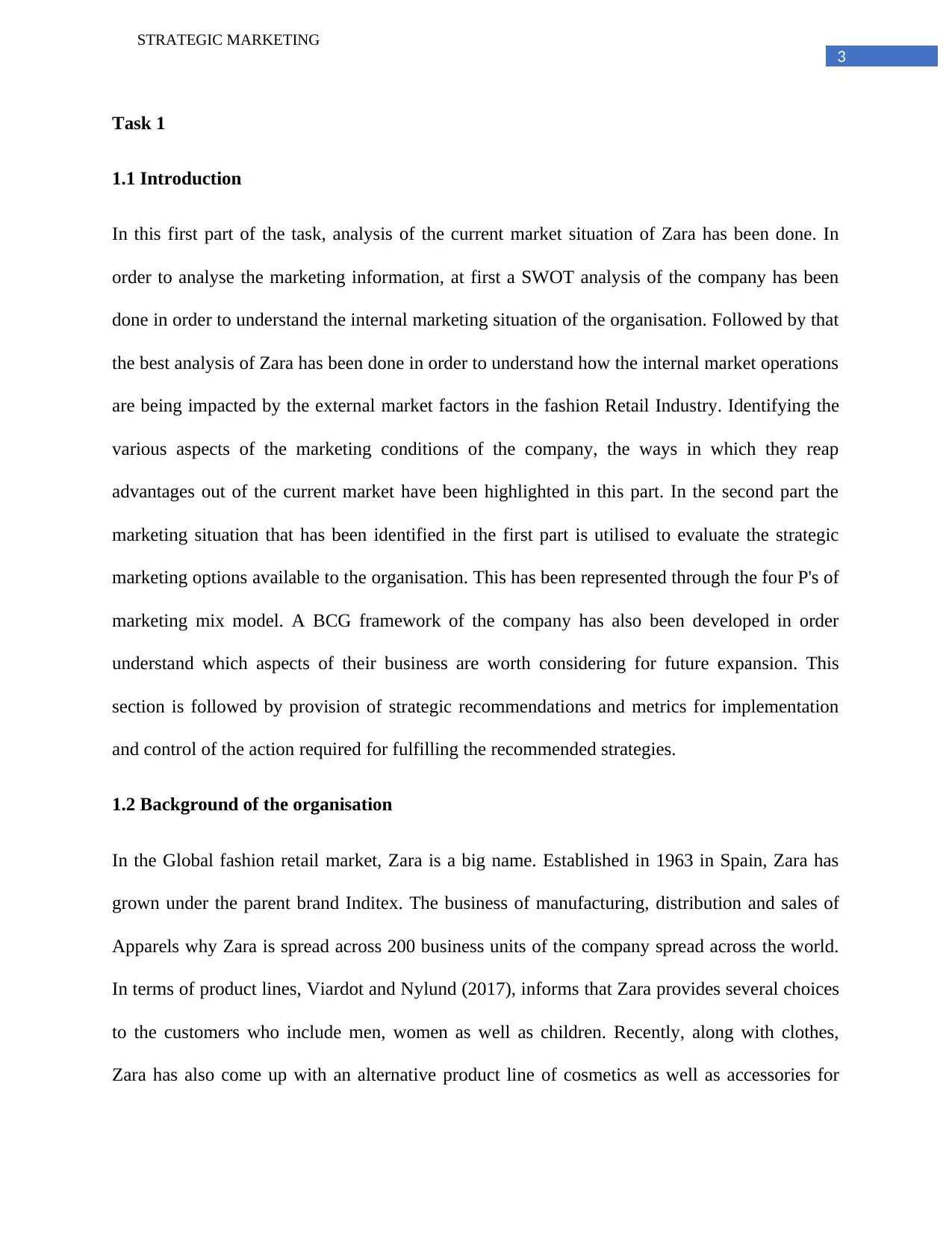
3
STRATEGIC MARKETING
Task 1
1.1 Introduction
In this first part of the task, analysis of the current market situation of Zara has been done. In
order to analyse the marketing information, at first a SWOT analysis of the company has been
done in order to understand the internal marketing situation of the organisation. Followed by that
the best analysis of Zara has been done in order to understand how the internal market operations
are being impacted by the external market factors in the fashion Retail Industry. Identifying the
various aspects of the marketing conditions of the company, the ways in which they reap
advantages out of the current market have been highlighted in this part. In the second part the
marketing situation that has been identified in the first part is utilised to evaluate the strategic
marketing options available to the organisation. This has been represented through the four P's of
marketing mix model. A BCG framework of the company has also been developed in order
understand which aspects of their business are worth considering for future expansion. This
section is followed by provision of strategic recommendations and metrics for implementation
and control of the action required for fulfilling the recommended strategies.
1.2 Background of the organisation
In the Global fashion retail market, Zara is a big name. Established in 1963 in Spain, Zara has
grown under the parent brand Inditex. The business of manufacturing, distribution and sales of
Apparels why Zara is spread across 200 business units of the company spread across the world.
In terms of product lines, Viardot and Nylund (2017), informs that Zara provides several choices
to the customers who include men, women as well as children. Recently, along with clothes,
Zara has also come up with an alternative product line of cosmetics as well as accessories for
STRATEGIC MARKETING
Task 1
1.1 Introduction
In this first part of the task, analysis of the current market situation of Zara has been done. In
order to analyse the marketing information, at first a SWOT analysis of the company has been
done in order to understand the internal marketing situation of the organisation. Followed by that
the best analysis of Zara has been done in order to understand how the internal market operations
are being impacted by the external market factors in the fashion Retail Industry. Identifying the
various aspects of the marketing conditions of the company, the ways in which they reap
advantages out of the current market have been highlighted in this part. In the second part the
marketing situation that has been identified in the first part is utilised to evaluate the strategic
marketing options available to the organisation. This has been represented through the four P's of
marketing mix model. A BCG framework of the company has also been developed in order
understand which aspects of their business are worth considering for future expansion. This
section is followed by provision of strategic recommendations and metrics for implementation
and control of the action required for fulfilling the recommended strategies.
1.2 Background of the organisation
In the Global fashion retail market, Zara is a big name. Established in 1963 in Spain, Zara has
grown under the parent brand Inditex. The business of manufacturing, distribution and sales of
Apparels why Zara is spread across 200 business units of the company spread across the world.
In terms of product lines, Viardot and Nylund (2017), informs that Zara provides several choices
to the customers who include men, women as well as children. Recently, along with clothes,
Zara has also come up with an alternative product line of cosmetics as well as accessories for
⊘ This is a preview!⊘
Do you want full access?
Subscribe today to unlock all pages.

Trusted by 1+ million students worldwide
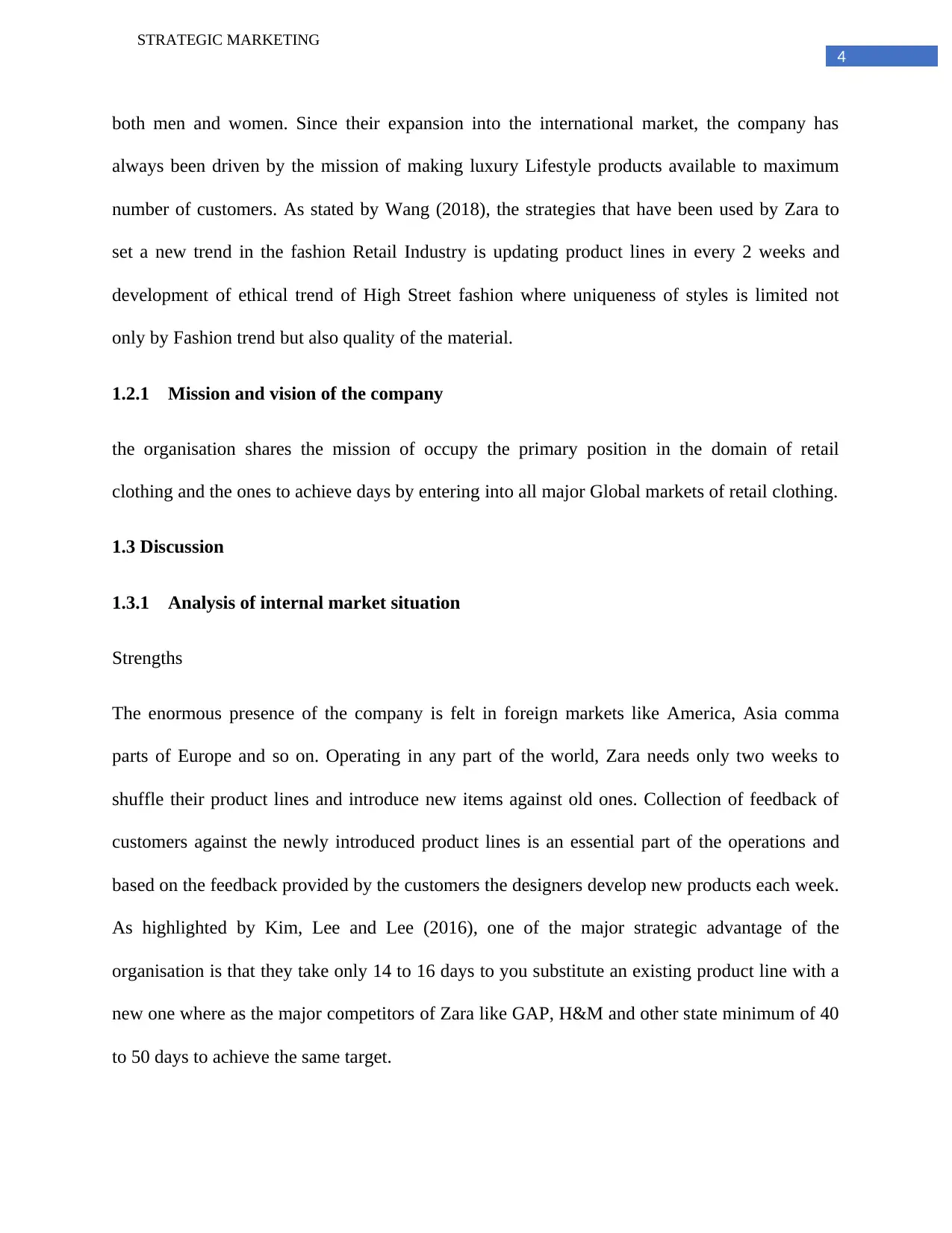
4
STRATEGIC MARKETING
both men and women. Since their expansion into the international market, the company has
always been driven by the mission of making luxury Lifestyle products available to maximum
number of customers. As stated by Wang (2018), the strategies that have been used by Zara to
set a new trend in the fashion Retail Industry is updating product lines in every 2 weeks and
development of ethical trend of High Street fashion where uniqueness of styles is limited not
only by Fashion trend but also quality of the material.
1.2.1 Mission and vision of the company
the organisation shares the mission of occupy the primary position in the domain of retail
clothing and the ones to achieve days by entering into all major Global markets of retail clothing.
1.3 Discussion
1.3.1 Analysis of internal market situation
Strengths
The enormous presence of the company is felt in foreign markets like America, Asia comma
parts of Europe and so on. Operating in any part of the world, Zara needs only two weeks to
shuffle their product lines and introduce new items against old ones. Collection of feedback of
customers against the newly introduced product lines is an essential part of the operations and
based on the feedback provided by the customers the designers develop new products each week.
As highlighted by Kim, Lee and Lee (2016), one of the major strategic advantage of the
organisation is that they take only 14 to 16 days to you substitute an existing product line with a
new one where as the major competitors of Zara like GAP, H&M and other state minimum of 40
to 50 days to achieve the same target.
STRATEGIC MARKETING
both men and women. Since their expansion into the international market, the company has
always been driven by the mission of making luxury Lifestyle products available to maximum
number of customers. As stated by Wang (2018), the strategies that have been used by Zara to
set a new trend in the fashion Retail Industry is updating product lines in every 2 weeks and
development of ethical trend of High Street fashion where uniqueness of styles is limited not
only by Fashion trend but also quality of the material.
1.2.1 Mission and vision of the company
the organisation shares the mission of occupy the primary position in the domain of retail
clothing and the ones to achieve days by entering into all major Global markets of retail clothing.
1.3 Discussion
1.3.1 Analysis of internal market situation
Strengths
The enormous presence of the company is felt in foreign markets like America, Asia comma
parts of Europe and so on. Operating in any part of the world, Zara needs only two weeks to
shuffle their product lines and introduce new items against old ones. Collection of feedback of
customers against the newly introduced product lines is an essential part of the operations and
based on the feedback provided by the customers the designers develop new products each week.
As highlighted by Kim, Lee and Lee (2016), one of the major strategic advantage of the
organisation is that they take only 14 to 16 days to you substitute an existing product line with a
new one where as the major competitors of Zara like GAP, H&M and other state minimum of 40
to 50 days to achieve the same target.
Paraphrase This Document
Need a fresh take? Get an instant paraphrase of this document with our AI Paraphraser
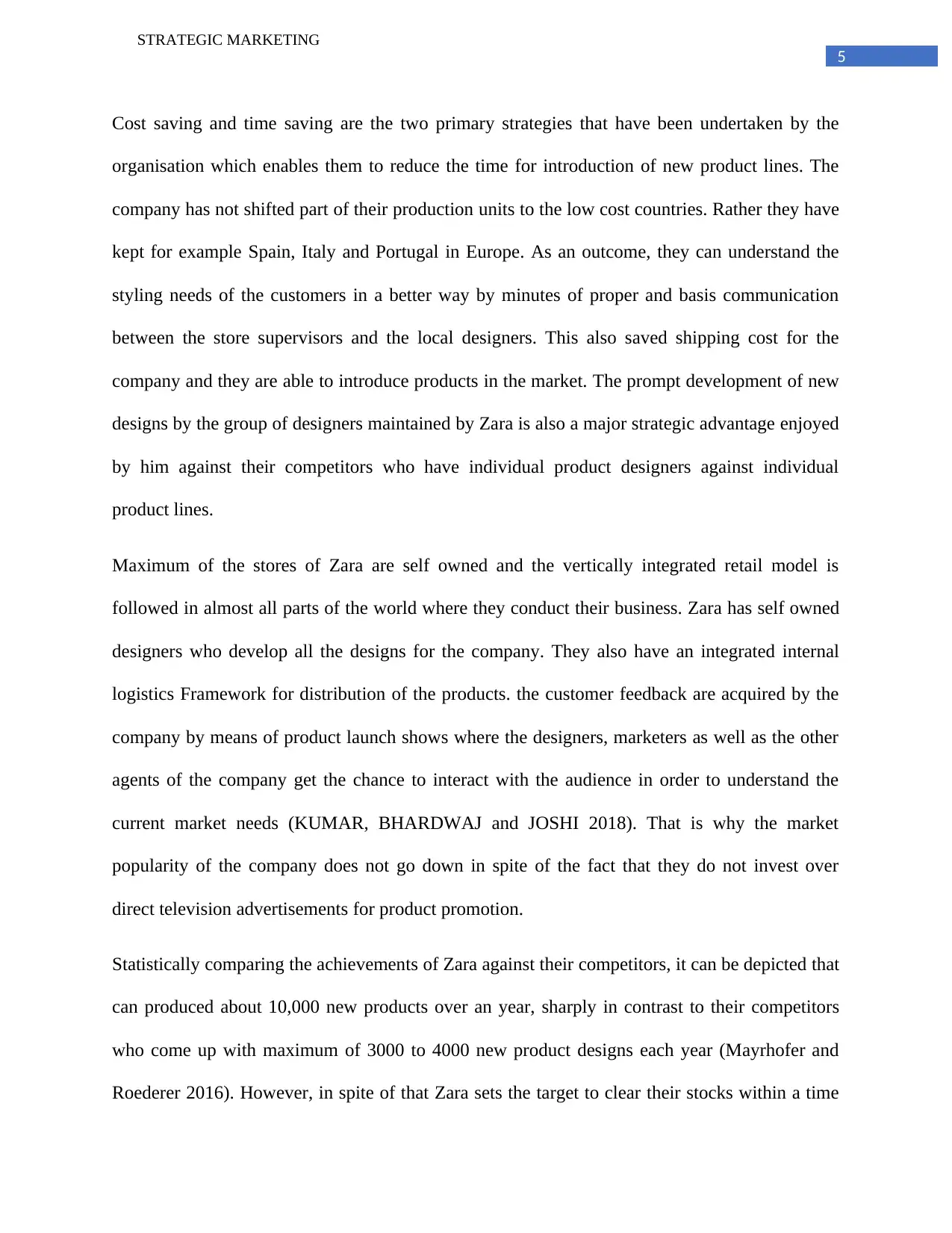
5
STRATEGIC MARKETING
Cost saving and time saving are the two primary strategies that have been undertaken by the
organisation which enables them to reduce the time for introduction of new product lines. The
company has not shifted part of their production units to the low cost countries. Rather they have
kept for example Spain, Italy and Portugal in Europe. As an outcome, they can understand the
styling needs of the customers in a better way by minutes of proper and basis communication
between the store supervisors and the local designers. This also saved shipping cost for the
company and they are able to introduce products in the market. The prompt development of new
designs by the group of designers maintained by Zara is also a major strategic advantage enjoyed
by him against their competitors who have individual product designers against individual
product lines.
Maximum of the stores of Zara are self owned and the vertically integrated retail model is
followed in almost all parts of the world where they conduct their business. Zara has self owned
designers who develop all the designs for the company. They also have an integrated internal
logistics Framework for distribution of the products. the customer feedback are acquired by the
company by means of product launch shows where the designers, marketers as well as the other
agents of the company get the chance to interact with the audience in order to understand the
current market needs (KUMAR, BHARDWAJ and JOSHI 2018). That is why the market
popularity of the company does not go down in spite of the fact that they do not invest over
direct television advertisements for product promotion.
Statistically comparing the achievements of Zara against their competitors, it can be depicted that
can produced about 10,000 new products over an year, sharply in contrast to their competitors
who come up with maximum of 3000 to 4000 new product designs each year (Mayrhofer and
Roederer 2016). However, in spite of that Zara sets the target to clear their stocks within a time
STRATEGIC MARKETING
Cost saving and time saving are the two primary strategies that have been undertaken by the
organisation which enables them to reduce the time for introduction of new product lines. The
company has not shifted part of their production units to the low cost countries. Rather they have
kept for example Spain, Italy and Portugal in Europe. As an outcome, they can understand the
styling needs of the customers in a better way by minutes of proper and basis communication
between the store supervisors and the local designers. This also saved shipping cost for the
company and they are able to introduce products in the market. The prompt development of new
designs by the group of designers maintained by Zara is also a major strategic advantage enjoyed
by him against their competitors who have individual product designers against individual
product lines.
Maximum of the stores of Zara are self owned and the vertically integrated retail model is
followed in almost all parts of the world where they conduct their business. Zara has self owned
designers who develop all the designs for the company. They also have an integrated internal
logistics Framework for distribution of the products. the customer feedback are acquired by the
company by means of product launch shows where the designers, marketers as well as the other
agents of the company get the chance to interact with the audience in order to understand the
current market needs (KUMAR, BHARDWAJ and JOSHI 2018). That is why the market
popularity of the company does not go down in spite of the fact that they do not invest over
direct television advertisements for product promotion.
Statistically comparing the achievements of Zara against their competitors, it can be depicted that
can produced about 10,000 new products over an year, sharply in contrast to their competitors
who come up with maximum of 3000 to 4000 new product designs each year (Mayrhofer and
Roederer 2016). However, in spite of that Zara sets the target to clear their stocks within a time
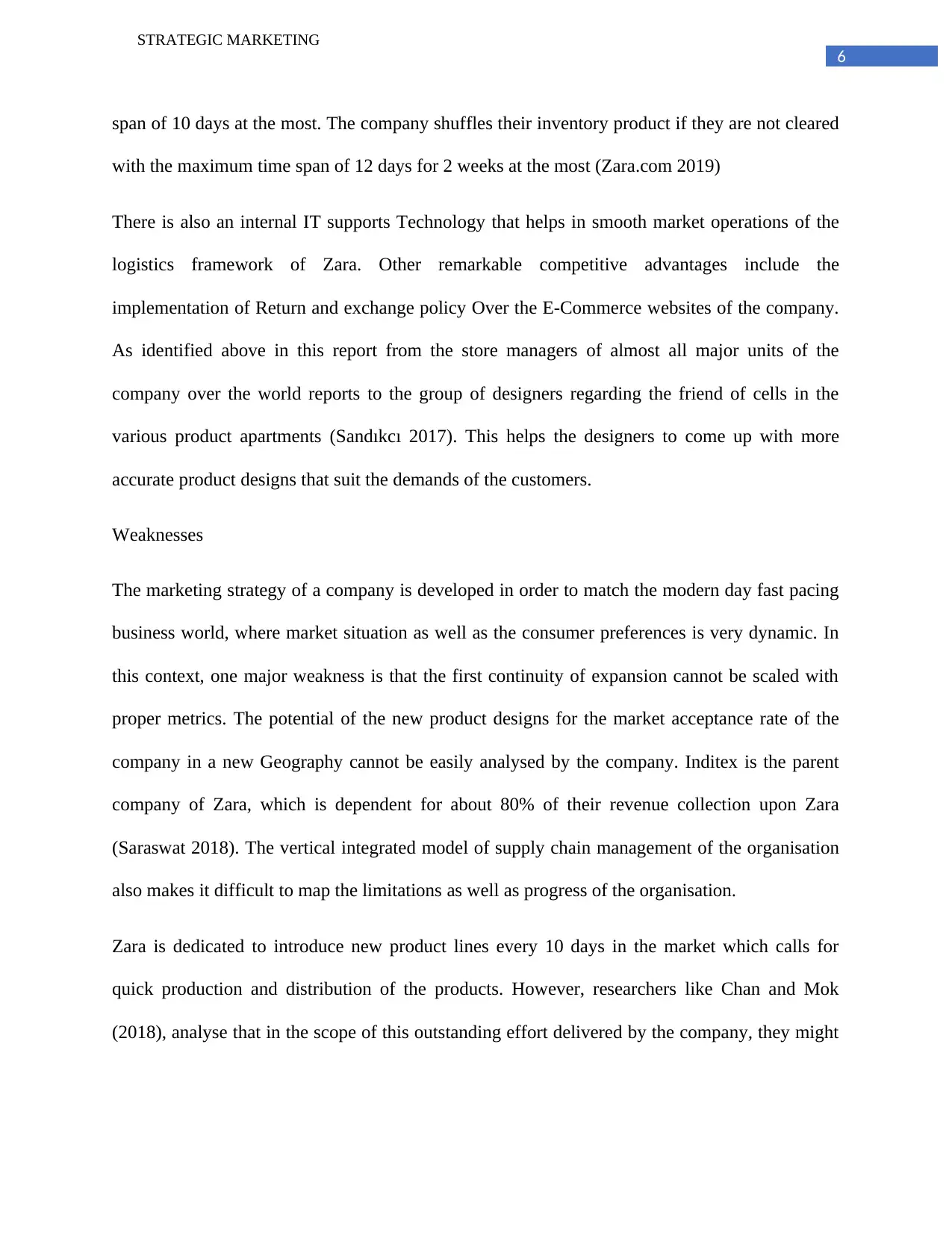
6
STRATEGIC MARKETING
span of 10 days at the most. The company shuffles their inventory product if they are not cleared
with the maximum time span of 12 days for 2 weeks at the most (Zara.com 2019)
There is also an internal IT supports Technology that helps in smooth market operations of the
logistics framework of Zara. Other remarkable competitive advantages include the
implementation of Return and exchange policy Over the E-Commerce websites of the company.
As identified above in this report from the store managers of almost all major units of the
company over the world reports to the group of designers regarding the friend of cells in the
various product apartments (Sandıkcı 2017). This helps the designers to come up with more
accurate product designs that suit the demands of the customers.
Weaknesses
The marketing strategy of a company is developed in order to match the modern day fast pacing
business world, where market situation as well as the consumer preferences is very dynamic. In
this context, one major weakness is that the first continuity of expansion cannot be scaled with
proper metrics. The potential of the new product designs for the market acceptance rate of the
company in a new Geography cannot be easily analysed by the company. Inditex is the parent
company of Zara, which is dependent for about 80% of their revenue collection upon Zara
(Saraswat 2018). The vertical integrated model of supply chain management of the organisation
also makes it difficult to map the limitations as well as progress of the organisation.
Zara is dedicated to introduce new product lines every 10 days in the market which calls for
quick production and distribution of the products. However, researchers like Chan and Mok
(2018), analyse that in the scope of this outstanding effort delivered by the company, they might
STRATEGIC MARKETING
span of 10 days at the most. The company shuffles their inventory product if they are not cleared
with the maximum time span of 12 days for 2 weeks at the most (Zara.com 2019)
There is also an internal IT supports Technology that helps in smooth market operations of the
logistics framework of Zara. Other remarkable competitive advantages include the
implementation of Return and exchange policy Over the E-Commerce websites of the company.
As identified above in this report from the store managers of almost all major units of the
company over the world reports to the group of designers regarding the friend of cells in the
various product apartments (Sandıkcı 2017). This helps the designers to come up with more
accurate product designs that suit the demands of the customers.
Weaknesses
The marketing strategy of a company is developed in order to match the modern day fast pacing
business world, where market situation as well as the consumer preferences is very dynamic. In
this context, one major weakness is that the first continuity of expansion cannot be scaled with
proper metrics. The potential of the new product designs for the market acceptance rate of the
company in a new Geography cannot be easily analysed by the company. Inditex is the parent
company of Zara, which is dependent for about 80% of their revenue collection upon Zara
(Saraswat 2018). The vertical integrated model of supply chain management of the organisation
also makes it difficult to map the limitations as well as progress of the organisation.
Zara is dedicated to introduce new product lines every 10 days in the market which calls for
quick production and distribution of the products. However, researchers like Chan and Mok
(2018), analyse that in the scope of this outstanding effort delivered by the company, they might
⊘ This is a preview!⊘
Do you want full access?
Subscribe today to unlock all pages.

Trusted by 1+ million students worldwide
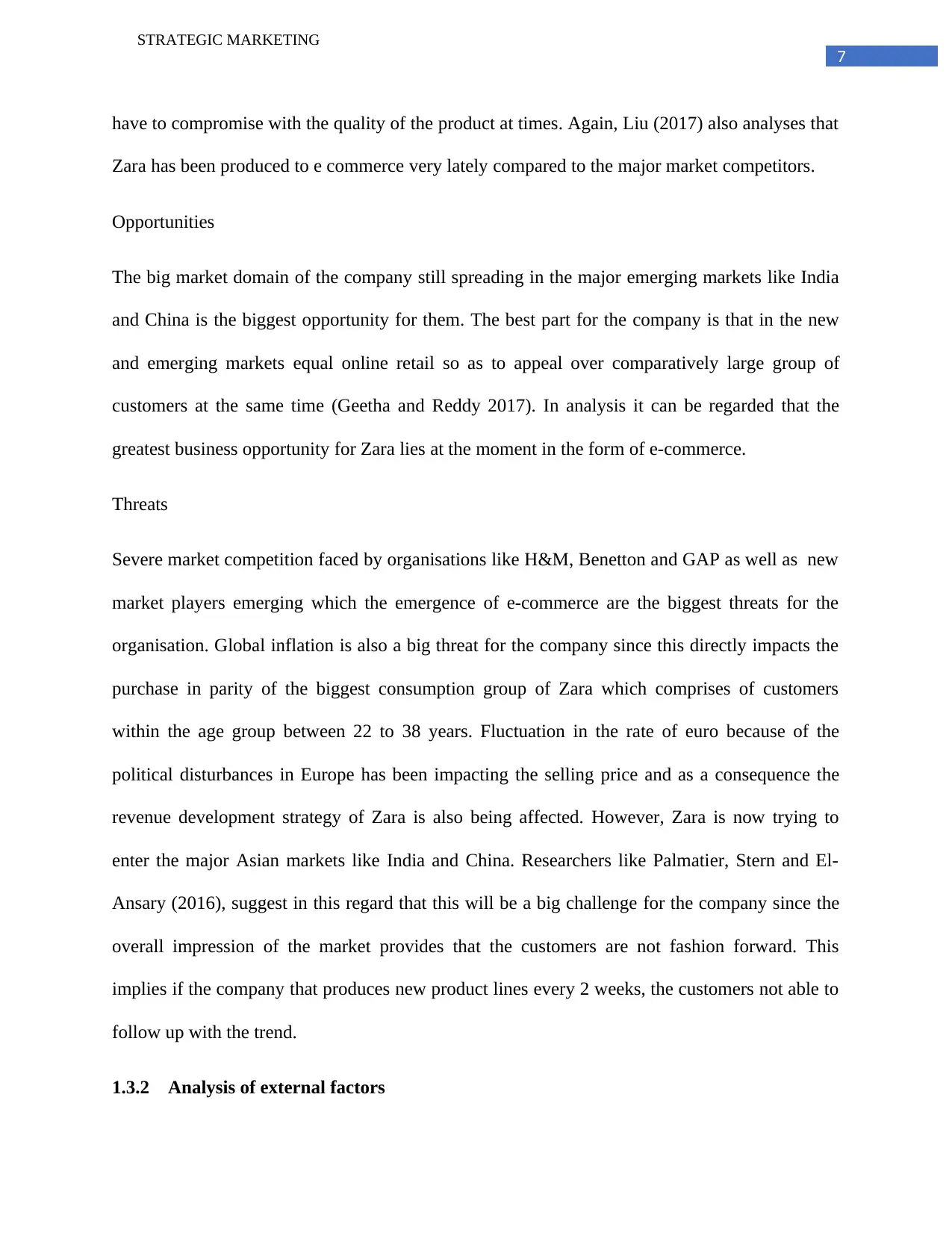
7
STRATEGIC MARKETING
have to compromise with the quality of the product at times. Again, Liu (2017) also analyses that
Zara has been produced to e commerce very lately compared to the major market competitors.
Opportunities
The big market domain of the company still spreading in the major emerging markets like India
and China is the biggest opportunity for them. The best part for the company is that in the new
and emerging markets equal online retail so as to appeal over comparatively large group of
customers at the same time (Geetha and Reddy 2017). In analysis it can be regarded that the
greatest business opportunity for Zara lies at the moment in the form of e-commerce.
Threats
Severe market competition faced by organisations like H&M, Benetton and GAP as well as new
market players emerging which the emergence of e-commerce are the biggest threats for the
organisation. Global inflation is also a big threat for the company since this directly impacts the
purchase in parity of the biggest consumption group of Zara which comprises of customers
within the age group between 22 to 38 years. Fluctuation in the rate of euro because of the
political disturbances in Europe has been impacting the selling price and as a consequence the
revenue development strategy of Zara is also being affected. However, Zara is now trying to
enter the major Asian markets like India and China. Researchers like Palmatier, Stern and El-
Ansary (2016), suggest in this regard that this will be a big challenge for the company since the
overall impression of the market provides that the customers are not fashion forward. This
implies if the company that produces new product lines every 2 weeks, the customers not able to
follow up with the trend.
1.3.2 Analysis of external factors
STRATEGIC MARKETING
have to compromise with the quality of the product at times. Again, Liu (2017) also analyses that
Zara has been produced to e commerce very lately compared to the major market competitors.
Opportunities
The big market domain of the company still spreading in the major emerging markets like India
and China is the biggest opportunity for them. The best part for the company is that in the new
and emerging markets equal online retail so as to appeal over comparatively large group of
customers at the same time (Geetha and Reddy 2017). In analysis it can be regarded that the
greatest business opportunity for Zara lies at the moment in the form of e-commerce.
Threats
Severe market competition faced by organisations like H&M, Benetton and GAP as well as new
market players emerging which the emergence of e-commerce are the biggest threats for the
organisation. Global inflation is also a big threat for the company since this directly impacts the
purchase in parity of the biggest consumption group of Zara which comprises of customers
within the age group between 22 to 38 years. Fluctuation in the rate of euro because of the
political disturbances in Europe has been impacting the selling price and as a consequence the
revenue development strategy of Zara is also being affected. However, Zara is now trying to
enter the major Asian markets like India and China. Researchers like Palmatier, Stern and El-
Ansary (2016), suggest in this regard that this will be a big challenge for the company since the
overall impression of the market provides that the customers are not fashion forward. This
implies if the company that produces new product lines every 2 weeks, the customers not able to
follow up with the trend.
1.3.2 Analysis of external factors
Paraphrase This Document
Need a fresh take? Get an instant paraphrase of this document with our AI Paraphraser
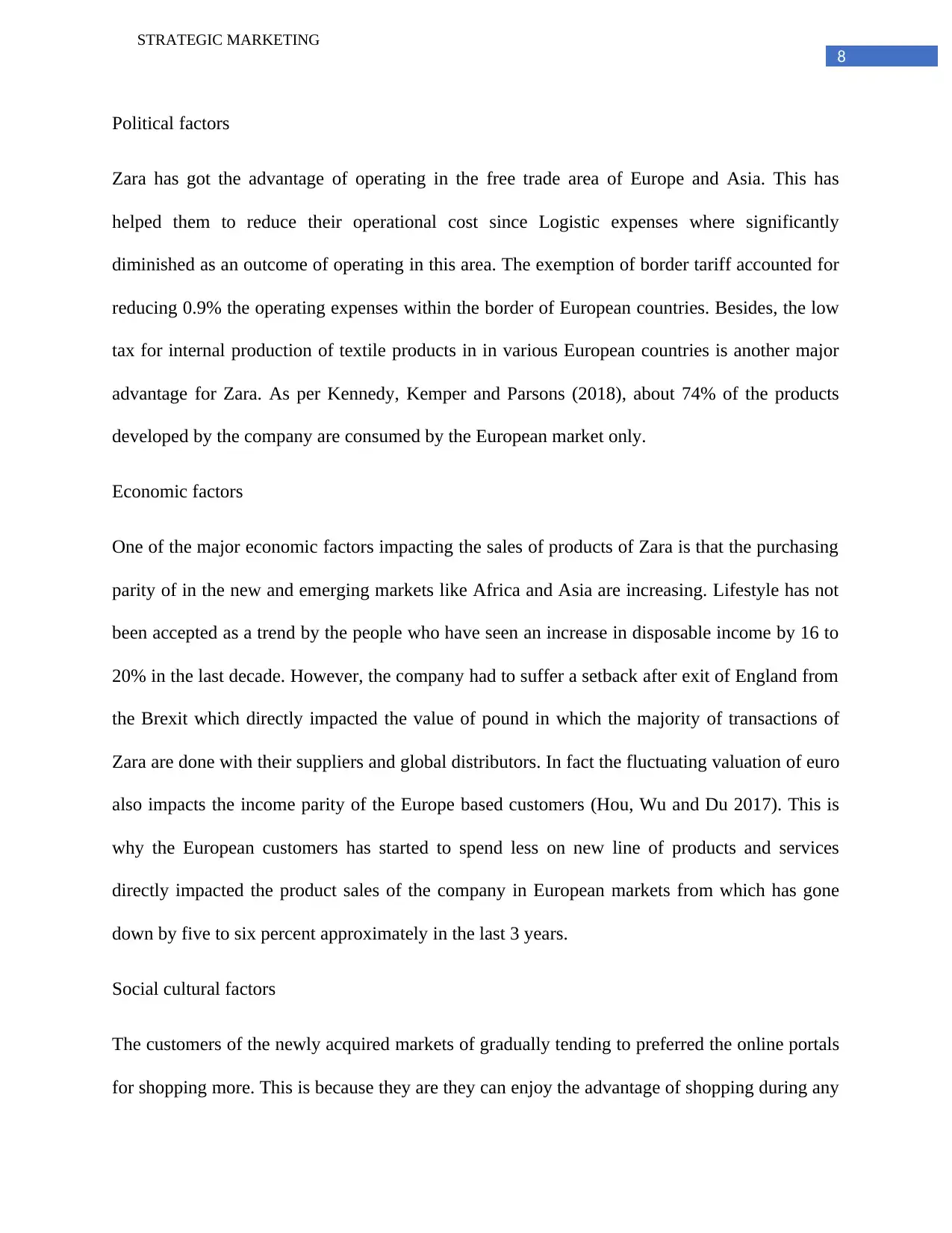
8
STRATEGIC MARKETING
Political factors
Zara has got the advantage of operating in the free trade area of Europe and Asia. This has
helped them to reduce their operational cost since Logistic expenses where significantly
diminished as an outcome of operating in this area. The exemption of border tariff accounted for
reducing 0.9% the operating expenses within the border of European countries. Besides, the low
tax for internal production of textile products in in various European countries is another major
advantage for Zara. As per Kennedy, Kemper and Parsons (2018), about 74% of the products
developed by the company are consumed by the European market only.
Economic factors
One of the major economic factors impacting the sales of products of Zara is that the purchasing
parity of in the new and emerging markets like Africa and Asia are increasing. Lifestyle has not
been accepted as a trend by the people who have seen an increase in disposable income by 16 to
20% in the last decade. However, the company had to suffer a setback after exit of England from
the Brexit which directly impacted the value of pound in which the majority of transactions of
Zara are done with their suppliers and global distributors. In fact the fluctuating valuation of euro
also impacts the income parity of the Europe based customers (Hou, Wu and Du 2017). This is
why the European customers has started to spend less on new line of products and services
directly impacted the product sales of the company in European markets from which has gone
down by five to six percent approximately in the last 3 years.
Social cultural factors
The customers of the newly acquired markets of gradually tending to preferred the online portals
for shopping more. This is because they are they can enjoy the advantage of shopping during any
STRATEGIC MARKETING
Political factors
Zara has got the advantage of operating in the free trade area of Europe and Asia. This has
helped them to reduce their operational cost since Logistic expenses where significantly
diminished as an outcome of operating in this area. The exemption of border tariff accounted for
reducing 0.9% the operating expenses within the border of European countries. Besides, the low
tax for internal production of textile products in in various European countries is another major
advantage for Zara. As per Kennedy, Kemper and Parsons (2018), about 74% of the products
developed by the company are consumed by the European market only.
Economic factors
One of the major economic factors impacting the sales of products of Zara is that the purchasing
parity of in the new and emerging markets like Africa and Asia are increasing. Lifestyle has not
been accepted as a trend by the people who have seen an increase in disposable income by 16 to
20% in the last decade. However, the company had to suffer a setback after exit of England from
the Brexit which directly impacted the value of pound in which the majority of transactions of
Zara are done with their suppliers and global distributors. In fact the fluctuating valuation of euro
also impacts the income parity of the Europe based customers (Hou, Wu and Du 2017). This is
why the European customers has started to spend less on new line of products and services
directly impacted the product sales of the company in European markets from which has gone
down by five to six percent approximately in the last 3 years.
Social cultural factors
The customers of the newly acquired markets of gradually tending to preferred the online portals
for shopping more. This is because they are they can enjoy the advantage of shopping during any
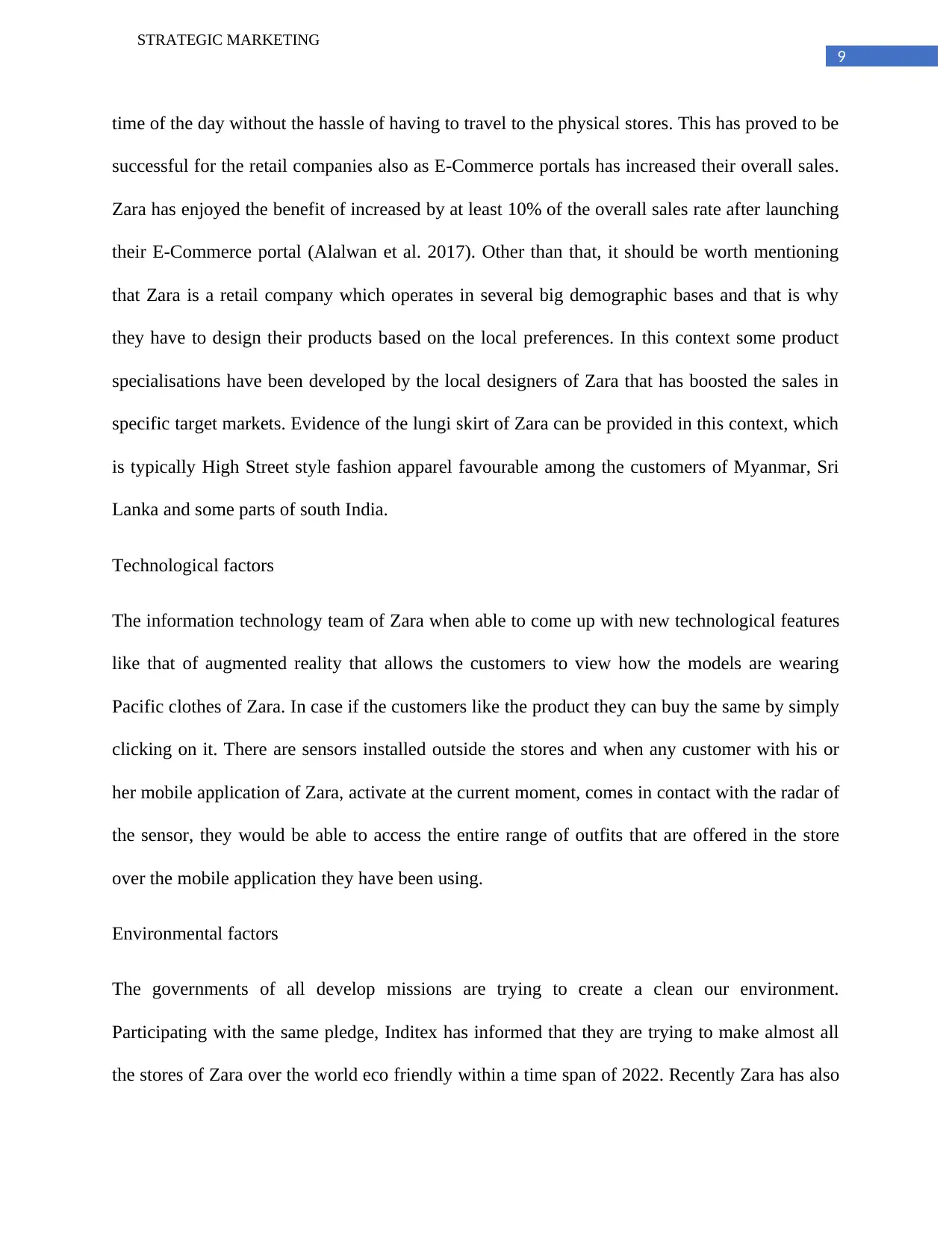
9
STRATEGIC MARKETING
time of the day without the hassle of having to travel to the physical stores. This has proved to be
successful for the retail companies also as E-Commerce portals has increased their overall sales.
Zara has enjoyed the benefit of increased by at least 10% of the overall sales rate after launching
their E-Commerce portal (Alalwan et al. 2017). Other than that, it should be worth mentioning
that Zara is a retail company which operates in several big demographic bases and that is why
they have to design their products based on the local preferences. In this context some product
specialisations have been developed by the local designers of Zara that has boosted the sales in
specific target markets. Evidence of the lungi skirt of Zara can be provided in this context, which
is typically High Street style fashion apparel favourable among the customers of Myanmar, Sri
Lanka and some parts of south India.
Technological factors
The information technology team of Zara when able to come up with new technological features
like that of augmented reality that allows the customers to view how the models are wearing
Pacific clothes of Zara. In case if the customers like the product they can buy the same by simply
clicking on it. There are sensors installed outside the stores and when any customer with his or
her mobile application of Zara, activate at the current moment, comes in contact with the radar of
the sensor, they would be able to access the entire range of outfits that are offered in the store
over the mobile application they have been using.
Environmental factors
The governments of all develop missions are trying to create a clean our environment.
Participating with the same pledge, Inditex has informed that they are trying to make almost all
the stores of Zara over the world eco friendly within a time span of 2022. Recently Zara has also
STRATEGIC MARKETING
time of the day without the hassle of having to travel to the physical stores. This has proved to be
successful for the retail companies also as E-Commerce portals has increased their overall sales.
Zara has enjoyed the benefit of increased by at least 10% of the overall sales rate after launching
their E-Commerce portal (Alalwan et al. 2017). Other than that, it should be worth mentioning
that Zara is a retail company which operates in several big demographic bases and that is why
they have to design their products based on the local preferences. In this context some product
specialisations have been developed by the local designers of Zara that has boosted the sales in
specific target markets. Evidence of the lungi skirt of Zara can be provided in this context, which
is typically High Street style fashion apparel favourable among the customers of Myanmar, Sri
Lanka and some parts of south India.
Technological factors
The information technology team of Zara when able to come up with new technological features
like that of augmented reality that allows the customers to view how the models are wearing
Pacific clothes of Zara. In case if the customers like the product they can buy the same by simply
clicking on it. There are sensors installed outside the stores and when any customer with his or
her mobile application of Zara, activate at the current moment, comes in contact with the radar of
the sensor, they would be able to access the entire range of outfits that are offered in the store
over the mobile application they have been using.
Environmental factors
The governments of all develop missions are trying to create a clean our environment.
Participating with the same pledge, Inditex has informed that they are trying to make almost all
the stores of Zara over the world eco friendly within a time span of 2022. Recently Zara has also
⊘ This is a preview!⊘
Do you want full access?
Subscribe today to unlock all pages.

Trusted by 1+ million students worldwide
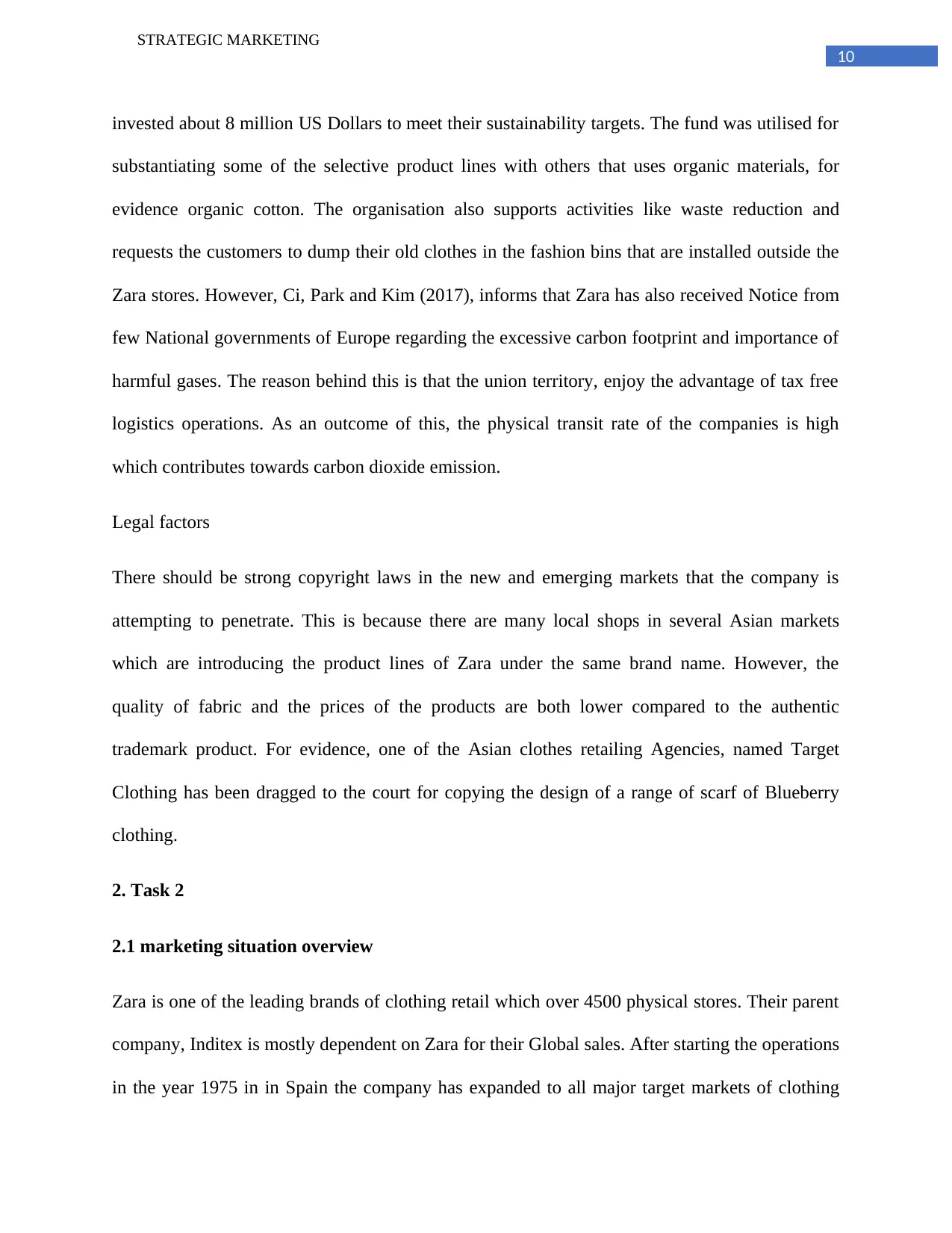
10
STRATEGIC MARKETING
invested about 8 million US Dollars to meet their sustainability targets. The fund was utilised for
substantiating some of the selective product lines with others that uses organic materials, for
evidence organic cotton. The organisation also supports activities like waste reduction and
requests the customers to dump their old clothes in the fashion bins that are installed outside the
Zara stores. However, Ci, Park and Kim (2017), informs that Zara has also received Notice from
few National governments of Europe regarding the excessive carbon footprint and importance of
harmful gases. The reason behind this is that the union territory, enjoy the advantage of tax free
logistics operations. As an outcome of this, the physical transit rate of the companies is high
which contributes towards carbon dioxide emission.
Legal factors
There should be strong copyright laws in the new and emerging markets that the company is
attempting to penetrate. This is because there are many local shops in several Asian markets
which are introducing the product lines of Zara under the same brand name. However, the
quality of fabric and the prices of the products are both lower compared to the authentic
trademark product. For evidence, one of the Asian clothes retailing Agencies, named Target
Clothing has been dragged to the court for copying the design of a range of scarf of Blueberry
clothing.
2. Task 2
2.1 marketing situation overview
Zara is one of the leading brands of clothing retail which over 4500 physical stores. Their parent
company, Inditex is mostly dependent on Zara for their Global sales. After starting the operations
in the year 1975 in in Spain the company has expanded to all major target markets of clothing
STRATEGIC MARKETING
invested about 8 million US Dollars to meet their sustainability targets. The fund was utilised for
substantiating some of the selective product lines with others that uses organic materials, for
evidence organic cotton. The organisation also supports activities like waste reduction and
requests the customers to dump their old clothes in the fashion bins that are installed outside the
Zara stores. However, Ci, Park and Kim (2017), informs that Zara has also received Notice from
few National governments of Europe regarding the excessive carbon footprint and importance of
harmful gases. The reason behind this is that the union territory, enjoy the advantage of tax free
logistics operations. As an outcome of this, the physical transit rate of the companies is high
which contributes towards carbon dioxide emission.
Legal factors
There should be strong copyright laws in the new and emerging markets that the company is
attempting to penetrate. This is because there are many local shops in several Asian markets
which are introducing the product lines of Zara under the same brand name. However, the
quality of fabric and the prices of the products are both lower compared to the authentic
trademark product. For evidence, one of the Asian clothes retailing Agencies, named Target
Clothing has been dragged to the court for copying the design of a range of scarf of Blueberry
clothing.
2. Task 2
2.1 marketing situation overview
Zara is one of the leading brands of clothing retail which over 4500 physical stores. Their parent
company, Inditex is mostly dependent on Zara for their Global sales. After starting the operations
in the year 1975 in in Spain the company has expanded to all major target markets of clothing
Paraphrase This Document
Need a fresh take? Get an instant paraphrase of this document with our AI Paraphraser
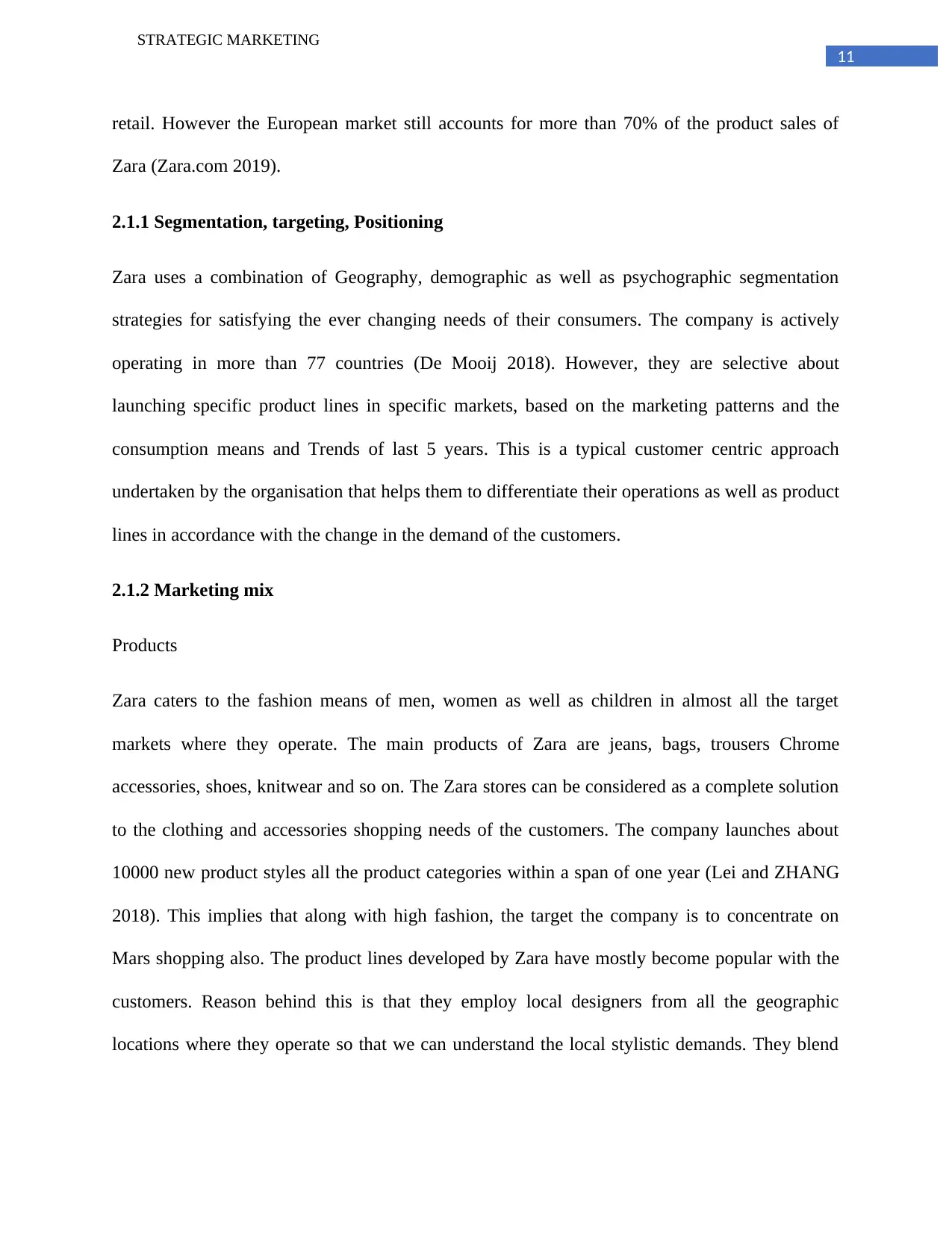
11
STRATEGIC MARKETING
retail. However the European market still accounts for more than 70% of the product sales of
Zara (Zara.com 2019).
2.1.1 Segmentation, targeting, Positioning
Zara uses a combination of Geography, demographic as well as psychographic segmentation
strategies for satisfying the ever changing needs of their consumers. The company is actively
operating in more than 77 countries (De Mooij 2018). However, they are selective about
launching specific product lines in specific markets, based on the marketing patterns and the
consumption means and Trends of last 5 years. This is a typical customer centric approach
undertaken by the organisation that helps them to differentiate their operations as well as product
lines in accordance with the change in the demand of the customers.
2.1.2 Marketing mix
Products
Zara caters to the fashion means of men, women as well as children in almost all the target
markets where they operate. The main products of Zara are jeans, bags, trousers Chrome
accessories, shoes, knitwear and so on. The Zara stores can be considered as a complete solution
to the clothing and accessories shopping needs of the customers. The company launches about
10000 new product styles all the product categories within a span of one year (Lei and ZHANG
2018). This implies that along with high fashion, the target the company is to concentrate on
Mars shopping also. The product lines developed by Zara have mostly become popular with the
customers. Reason behind this is that they employ local designers from all the geographic
locations where they operate so that we can understand the local stylistic demands. They blend
STRATEGIC MARKETING
retail. However the European market still accounts for more than 70% of the product sales of
Zara (Zara.com 2019).
2.1.1 Segmentation, targeting, Positioning
Zara uses a combination of Geography, demographic as well as psychographic segmentation
strategies for satisfying the ever changing needs of their consumers. The company is actively
operating in more than 77 countries (De Mooij 2018). However, they are selective about
launching specific product lines in specific markets, based on the marketing patterns and the
consumption means and Trends of last 5 years. This is a typical customer centric approach
undertaken by the organisation that helps them to differentiate their operations as well as product
lines in accordance with the change in the demand of the customers.
2.1.2 Marketing mix
Products
Zara caters to the fashion means of men, women as well as children in almost all the target
markets where they operate. The main products of Zara are jeans, bags, trousers Chrome
accessories, shoes, knitwear and so on. The Zara stores can be considered as a complete solution
to the clothing and accessories shopping needs of the customers. The company launches about
10000 new product styles all the product categories within a span of one year (Lei and ZHANG
2018). This implies that along with high fashion, the target the company is to concentrate on
Mars shopping also. The product lines developed by Zara have mostly become popular with the
customers. Reason behind this is that they employ local designers from all the geographic
locations where they operate so that we can understand the local stylistic demands. They blend
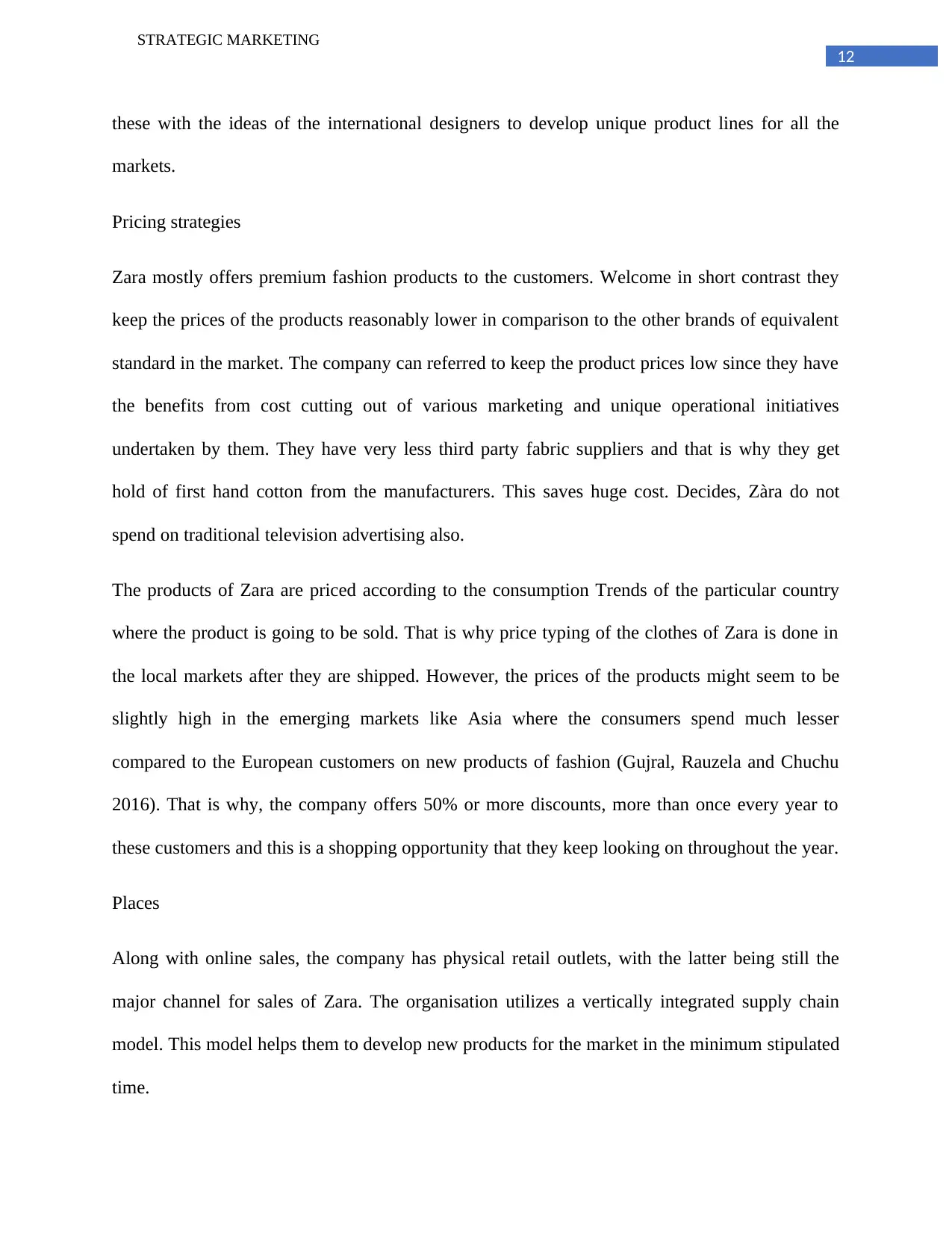
12
STRATEGIC MARKETING
these with the ideas of the international designers to develop unique product lines for all the
markets.
Pricing strategies
Zara mostly offers premium fashion products to the customers. Welcome in short contrast they
keep the prices of the products reasonably lower in comparison to the other brands of equivalent
standard in the market. The company can referred to keep the product prices low since they have
the benefits from cost cutting out of various marketing and unique operational initiatives
undertaken by them. They have very less third party fabric suppliers and that is why they get
hold of first hand cotton from the manufacturers. This saves huge cost. Decides, Zàra do not
spend on traditional television advertising also.
The products of Zara are priced according to the consumption Trends of the particular country
where the product is going to be sold. That is why price typing of the clothes of Zara is done in
the local markets after they are shipped. However, the prices of the products might seem to be
slightly high in the emerging markets like Asia where the consumers spend much lesser
compared to the European customers on new products of fashion (Gujral, Rauzela and Chuchu
2016). That is why, the company offers 50% or more discounts, more than once every year to
these customers and this is a shopping opportunity that they keep looking on throughout the year.
Places
Along with online sales, the company has physical retail outlets, with the latter being still the
major channel for sales of Zara. The organisation utilizes a vertically integrated supply chain
model. This model helps them to develop new products for the market in the minimum stipulated
time.
STRATEGIC MARKETING
these with the ideas of the international designers to develop unique product lines for all the
markets.
Pricing strategies
Zara mostly offers premium fashion products to the customers. Welcome in short contrast they
keep the prices of the products reasonably lower in comparison to the other brands of equivalent
standard in the market. The company can referred to keep the product prices low since they have
the benefits from cost cutting out of various marketing and unique operational initiatives
undertaken by them. They have very less third party fabric suppliers and that is why they get
hold of first hand cotton from the manufacturers. This saves huge cost. Decides, Zàra do not
spend on traditional television advertising also.
The products of Zara are priced according to the consumption Trends of the particular country
where the product is going to be sold. That is why price typing of the clothes of Zara is done in
the local markets after they are shipped. However, the prices of the products might seem to be
slightly high in the emerging markets like Asia where the consumers spend much lesser
compared to the European customers on new products of fashion (Gujral, Rauzela and Chuchu
2016). That is why, the company offers 50% or more discounts, more than once every year to
these customers and this is a shopping opportunity that they keep looking on throughout the year.
Places
Along with online sales, the company has physical retail outlets, with the latter being still the
major channel for sales of Zara. The organisation utilizes a vertically integrated supply chain
model. This model helps them to develop new products for the market in the minimum stipulated
time.
⊘ This is a preview!⊘
Do you want full access?
Subscribe today to unlock all pages.

Trusted by 1+ million students worldwide
1 out of 19
Related Documents
Your All-in-One AI-Powered Toolkit for Academic Success.
+13062052269
info@desklib.com
Available 24*7 on WhatsApp / Email
![[object Object]](/_next/static/media/star-bottom.7253800d.svg)
Unlock your academic potential
Copyright © 2020–2025 A2Z Services. All Rights Reserved. Developed and managed by ZUCOL.





